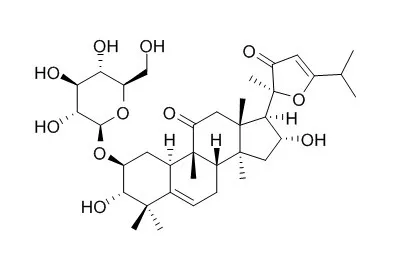| Structure Identification: |
| J Asian Nat Prod Res. 2006 Sep;8(6):491-4. | | Two new triterpenoids from Picria fel-terrae.[Pubmed: 16931422] |
METHODS AND RESULTS:
Two new triterpenoids, picfeltarraegenin VII (1) and Picfeltarraenin X (2), have been isolated from Picria fel-terrae Lour., along with three known ones, picfeltarraegenin VI (3), picfeltarraenins VI (4) and VII (5).
CONCLUSIONS:
Their structures have been elucidated by means of spectroscopic methods. | | Pharmacogn Mag. 2013 Oct;9(Suppl 1):S25-31. | | Bioassay- and liquid chromatography/mass spectrometry-guided acetylcholinesterase inhibitors from Picriafel-terrae.[Pubmed: 24143041] | Picria fel-terrae is a traditional Chinese medicine.
METHODS AND RESULTS:
A new approach to the search for acetylcholinesterase (AChE) inhibitors from Picria fel-terrae is presented.
Bioassay- and LC-MS-guided fractionation of the ethyl acetate extract was from traditional Chinese medicine P.fel-terrae. Following primary extraction, the ethyl acetate extracts fraction of P.fel-terrae showed strong AChE inhibitory activities. So the sample was separated using highperformance liquid chromatography (HPLC). The effluent was split towards two identical 96-well fraction collectors, and the presence of the biologically interesting portion and chromatographic fractions could be readily detected by analyzing selected ion chromatograms through an electrophoresis-electrospray ionization mass spectrometry (ESIMS) system for accurate mass measurement. One 96-well plate was used for a bioassay (AChE-inhibitory assay) and detected the bioactivity and position of the relevant peak in the chromatogram. The positive well in the second 96-well plate was used for identification by LC-(+) ESIMS.
CONCLUSIONS:
As abovementioned, the AChE inhibitory constituents from P.fel-terrae by LC-bioassay-ESIMS were rapid identified. Liquid chromatography/ mass spectrometry (LC-MS) screening detected the presence of six active compounds, identified as picfeltarraenin IA (1), picfeltarraenin IB (2), picfeltarraenin IV (3), Picfeltarraenin X (4), Picfeltarraenin XI (5), and one unknown compound. The structures were further determined by 13C NMR. The six compounds expressed stronger AChE inhibition than the known AChE inhibitorTacrine. Above all, the value of this LC-bioassay-ESIMS methodology is highlighted by the finding and structure elucidation of the active constituents from many other structural families of natural products. |
|






 Cell. 2018 Jan 11;172(1-2):249-261.e12. doi: 10.1016/j.cell.2017.12.019.IF=36.216(2019)
Cell. 2018 Jan 11;172(1-2):249-261.e12. doi: 10.1016/j.cell.2017.12.019.IF=36.216(2019) Cell Metab. 2020 Mar 3;31(3):534-548.e5. doi: 10.1016/j.cmet.2020.01.002.IF=22.415(2019)
Cell Metab. 2020 Mar 3;31(3):534-548.e5. doi: 10.1016/j.cmet.2020.01.002.IF=22.415(2019) Mol Cell. 2017 Nov 16;68(4):673-685.e6. doi: 10.1016/j.molcel.2017.10.022.IF=14.548(2019)
Mol Cell. 2017 Nov 16;68(4):673-685.e6. doi: 10.1016/j.molcel.2017.10.022.IF=14.548(2019)